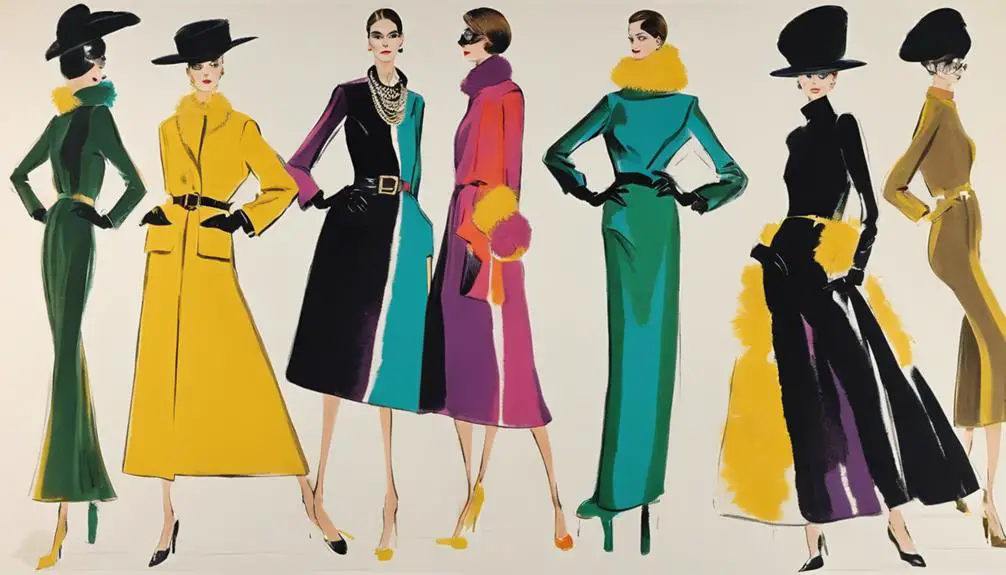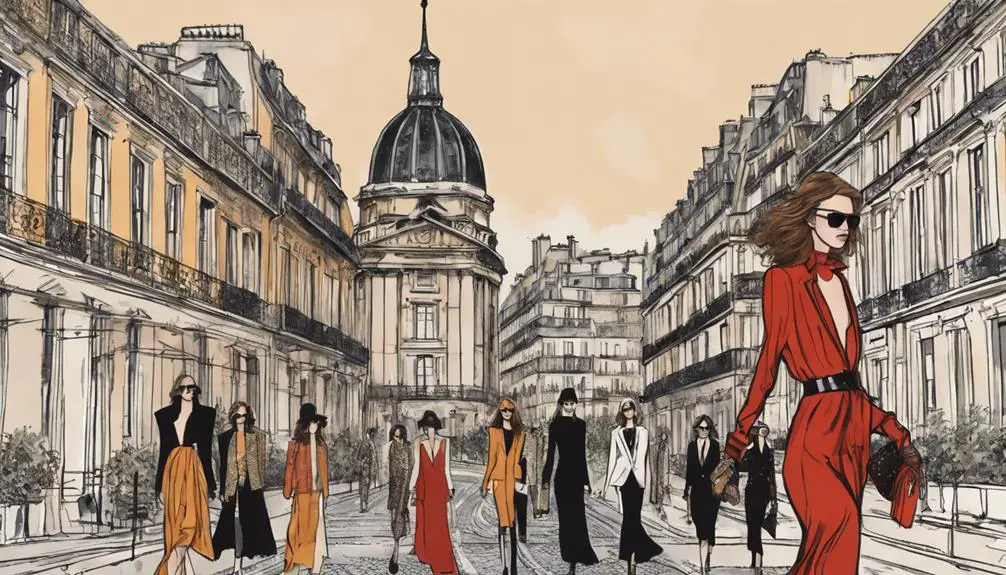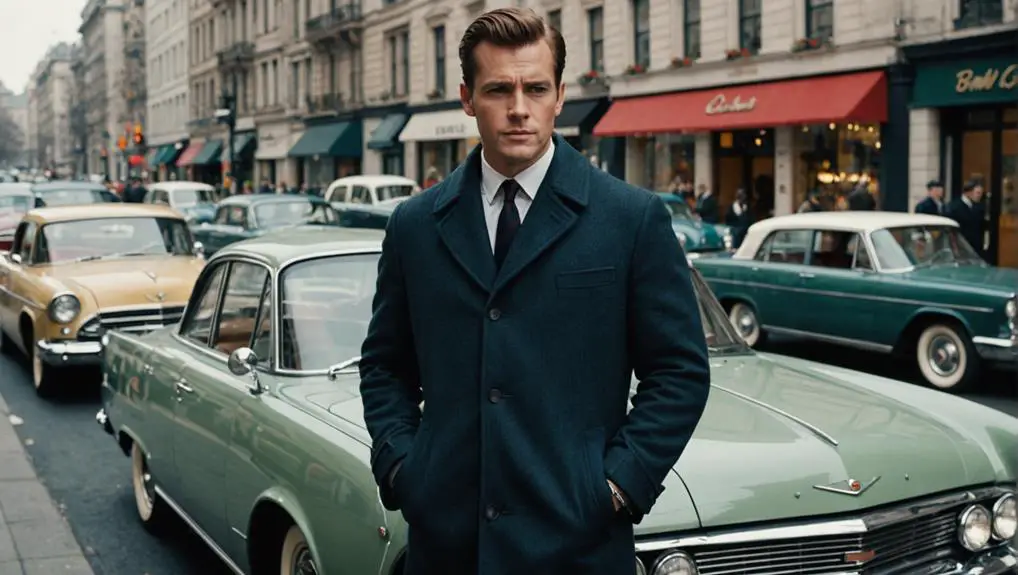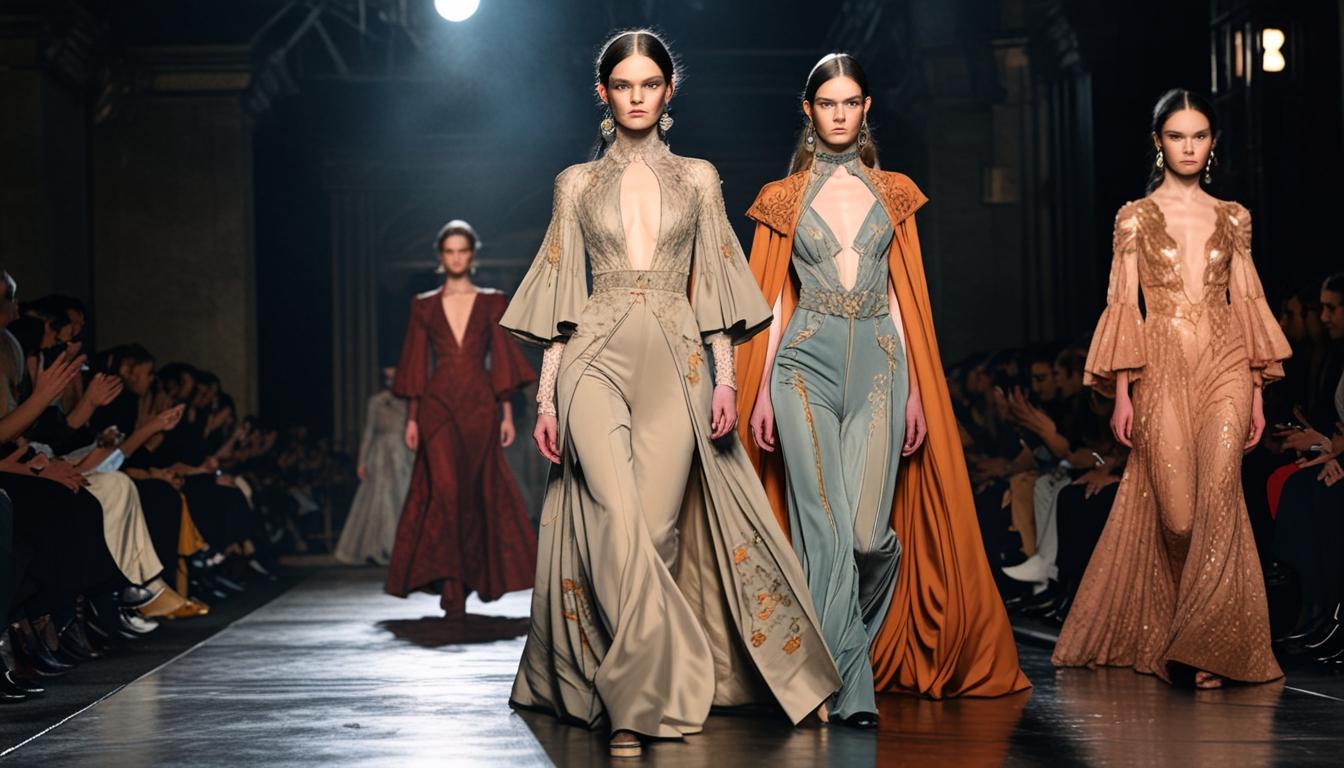The House of Saint Laurent is known for groundbreaking designs that changed fashion forever. The "Le Smoking" tuxedo suit empowered women by offering tailored elegance traditionally reserved for men. In 1965, the "Mondrian" dress blurred lines between art and fashion with its geometric pattern. Collections like "La collection du scandale" in 1971 challenged societal norms. Saint Laurent merged military aesthetics with stylish civilian pieces, creating timeless staples like the Safari jacket. His work not only highlighted femininity but also championed women's empowerment. Explore further, and you'll discover more about how his designs continue to influence fashion today.
Early Influences on Design

Yves Saint Laurent's early influences on design played a crucial role in shaping his revolutionary approach to fashion. Starting his early career with the Beat collection for Christian Dior in 1960, he introduced youth culture to high fashion at a time when it was desperately needed. Inspired by the existentialist movement in Paris, this collection featured groundbreaking pieces, like the black leather jacket. With its crocodile pattern and mink lining, this jacket symbolized a significant shift toward youth-centric fashion in the 1960s. His early inspirations were also rooted in his upbringing, where cultural outings to the theater and opera established a strong artistic foundation, fueling his future innovations in fashion his early life influences.
After leaving Dior, Yves Saint Laurent didn't just rest on his laurels; he continued to innovate and push boundaries. As a fashion designer, he challenged traditional gender norms, embracing a more modern and fluid aesthetic. His designs often reflected his personal background, growing up in a feminine environment in Algeria. This upbringing deeply influenced his emphasis on elegance and femininity in his collections.
Collaboration was also key to Saint Laurent's success. He worked with notable artists and drew from diverse influences, creating collections that weren't only stylish but culturally significant. This approach helped solidify his fashion house as a leader in the industry, known for its boldness and creativity.
Iconic Collections and Pieces
The world of fashion was forever changed by Yves Saint Laurent's iconic collections and pieces, each one a bold statement that challenged conventions. One of his most revolutionary designs is the "Le Smoking" tuxedo suit, introduced in 1966. This daring piece transformed women's fashion, empowering them to embrace tailored elegance and defy traditional gender norms.
In 1965, the "Mondrian" dress made waves with its geometric patterns and vibrant colors, inspired by Dutch painter Piet Mondrian. This dress blurred the lines between fine art and high fashion, forever altering the concept of what a dress could be.
Fast forward to the Spring-Summer 1971 collection, famously dubbed "La collection du scandale." This fashion show shocked audiences with provocative designs that questioned societal expectations, showcasing Yves Saint Laurent's fearless approach to couture.
Another standout piece is the "Safari" jacket, launched in 1967. This design fused military inspiration with civilian chic, quickly becoming a staple in wardrobes worldwide. It encapsulated the evolving style of the era and showcased how fashion could be both functional and fashionable.
Yves Saint Laurent's innovation didn't stop there; his Fall/Winter 1960 collection featured a crocodile-embossed leather jacket, defining luxury and modern design. Each of these iconic collections and pieces reflects his visionary spirit, making an indelible mark on the fashion world that continues to inspire designers today.
Cultural Impact and Legacy

Few designers have made such a profound cultural impact as Yves Saint Laurent, whose work reshaped perceptions of fashion and identity. His introduction of the "Le Smoking" tuxedo suit for women challenged gender norms and became a powerful symbol of empowerment and elegance. This bold move not only redefined women's fashion but also sparked conversations about femininity and strength.
As fashion history demonstrates, his innovative designs, akin to those of Vivienne Westwood's vintage pieces, were pivotal in influencing the cultural landscape of their time.
In 1966, the launch of the SAINT LAURENT rive gauche boutique revolutionized haute couture, making stylish ready-to-wear accessible to a wider audience. This democratization of fashion allowed more people to express their individuality through clothing, further solidifying Yves Saint Laurent's influence on fashion history.
His groundbreaking Spring-Summer 1971 collection, known as "La collection du scandale," was another turning point. It pushed societal boundaries and showcased his ability to provoke thought and discussion through design.
Collaborations with contemporary artists like Piet Mondrian and Andy Warhol blurred the lines between fashion and art, showcasing how clothing could serve as a medium for artistic expression.
The establishment of the Fondation Pierre Bergé – Yves Saint Laurent, along with the opening of the Yves Saint Laurent museum in Paris in 2017, underscores his lasting legacy.
These institutions celebrate his contributions to contemporary fashion and culture, ensuring that his visionary ideas continue to inspire future generations. Yves Saint Laurent's cultural impact remains undeniable, shaping not just what we wear, but how we view ourselves and each other in the world of fashion.
Collaborations and Artistic Ventures
Collaborations and artistic ventures played a pivotal role in shaping Yves Saint Laurent's legacy, blending fashion with broader cultural narratives. One of his most iconic collaborations was with artist Piet Mondrian, resulting in the famous Mondrian dress in 1965. This innovative design transformed fashion by integrating geometric patterns and vibrant colors straight from the canvas into wearable art.
Saint Laurent didn't stop there; he also partnered with Claude Lalanne to create unique accessories that beautifully fused fashion with artistic expression. These accessories showcased his keen interest in innovative designs that pushed the boundaries of traditional fashion.
Additionally, he designed extravagant costumes for dancer Zizi Jeanmaire, reflecting his passion for stage design and performance art. His collaboration with contemporary artist Andy Warhol further highlighted the intersection of fashion and art, emphasizing the cultural significance of Saint Laurent's work during the 1970s.
This partnership not only showcased his ability to adapt to changing artistic landscapes but also helped elevate his brand's visual identity. Working with notable models like Betty Catroux and Laetitia Casta, Saint Laurent defined the essence of his brand.
These collaborations showcased a dynamic relationship between fashion and its muses, creating a powerful narrative that resonated through the years. Through these artistic ventures, you can see how Saint Laurent didn't just create clothes; he wove intricate stories that connected fashion to the world of art, shaping a legacy that continues to inspire.
Women in Saint Laurent's Vision

Yves Saint Laurent's vision for women redefined fashion in the 20th century, championing empowerment and individuality. His designs challenged traditional gender norms, allowing women to express themselves in ways previously unseen. The revolutionary "Le Smoking" tuxedo suit became a powerful symbol of this shift, illustrating how fashion could break barriers.
In 1966, he launched the SAINT LAURENT rive gauche line, which democratized high fashion by offering ready-to-wear collections. This made chic styles accessible to a wider audience of women, proving that luxury could be both attainable and stylish. His Spring-Summer 1971 collection, famously dubbed "La collection du scandale," celebrated women's liberation with bold, provocative designs that pushed societal boundaries.
Saint Laurent's collaborations with literary figures like Françoise Sagan deepened his understanding of women's emotions and experiences. He took this insight and infused it into his designs, creating pieces that resonated with the modern woman.
One striking example of his innovative approach is the introduction of the Safari jacket in 1967. This design cleverly blended military aesthetics with civilian wear, showcasing his knack for practicality without sacrificing style. By doing so, he empowered women to embrace their strength and individuality.
Through these remarkable designs, Yves Saint Laurent not only transformed women's fashion but also inspired a generation to redefine themselves. His legacy continues to influence the way women view empowerment in fashion today, reminding us that style can be a powerful tool for self-expression.



